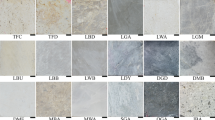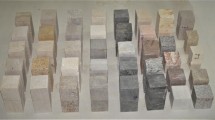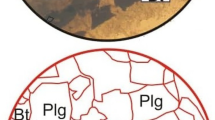Abstract
The first aim of this study is to determine the effect of the sample size on the Leeb hardness (HL), which is a non-destructive test, in magmatic rocks. For this scope, cubic samples with edge lengths of 3, 4, 5, 6, 7, 8, 9, and 10 cm from 15 different magmatic rocks (igneous, volcanic, and pyroclastic) were prepared, and variations of the HL values were measured. Based on the results, it was determined that as the strength values of magmatic rock samples increase, the effect of sample size on HL value decreases. Additionally, the minimum sample size, at which the HL value did not change, was found to be 7 cm. The second aim of this study is to examine the correlation between the HL values of the rocks’ minimum sample size, and the index properties were examined by the simple regression method. For this purpose, 76 various types of magmatic rock samples were tested in the laboratory in order to determine their dry and saturated HL values and index (P-wave velocity, dry density, porosity, and uniaxial compressive strength) values. The relationship between the dry and saturated HL values and the index properties of the samples was examined by simple regression analysis. Based on this analysis, a strong linear relationship was found between the index properties. In addition to this, a strong exponential relationship was determined between the dry and saturated HL and uniaxial compressive strength (UCS) values of these rocks, and the determination coefficients (R2) were found to be 0.85 and 0.86, respectively. The Leeb hardness test can be used as a non-destructive method where a regular-shaped rock sample is difficult to obtain (in rocks and/or historical structures) and to estimate the rock properties practically in the laboratory and field.







Similar content being viewed by others
References
Aldeeky H, Al Hattamleh O, Rababah S (2020) Assessing the uniaxial compressive strength and tangent Young’s modulus of basalt rock using the Leeb rebound hardness test. Mater Constr 70(340):e230. https://doi.org/10.3989/mc.2020.15119
Alvarez Grima M, Babuška R (1999) Fuzzy model for the prediction of unconfined compressive strength of rock samples. Int J Rock Mech Min Sci 36:339–349. https://doi.org/10.1016/S0148-9062(99)00007-8
André MF, Voldoire O, Vautier F, Roussel E, Phalip B, Morel D (2014) Impact of cement repointing on rates of sandstone decay in medieval churches of the French Massif Central. Geological Society, London, Special Publications 391:157–174. https://doi.org/10.1144/sp391.4
Aoki H, Matsukura Y (2008) Estimating the unconfined compressive strength of intact rocks from Equotip hardness. Bull EngGeol Environ 67:23–29. https://doi.org/10.1007/s10064-007-0116-z
Asiri Y (2017) Standardized Process for Filed Estimation of Unconfined Compressive Strength Using Leeb Hardness. Master, Dalhousie University
Asiri Y, Corkum A, El Naggar H (2016) Leeb hardness test for UCS estimation of sandstone. Paper presented at the 69th Annual Canadıan Geotechnıcal Conference, Vancouer, October 2016
ASTM A956 (2012) Standard Test Method for Leeb Hardness Testing of Steel Products. ASTM International, West Conshohocken
ASTM E494 (2010) Standard Practice for Measuring Ultrasonic Velocity in Materials. ASTM International, West Conshohocken
Bieniawski ZT (1989) Engineering rock mass classifications: a complete manual for engineers and geologists in mining, civil, and petroleum engineering. Wiley
Coombes MA, Feal-Pérez A, Naylor LA, Wilhelm K (2013) A non-destructive tool for detecting changes in the hardness of engineering materials: Application of the Equotip durometer in the coastal zone. EngGeol 167:14–19. https://doi.org/10.1016/j.enggeo.2013.10.003
Corkum AG, Asiri Y, El Naggar H, Kinakin D (2018) The Leeb hardness test for rock: an updated methodology and UCS correlation. Rock Mech Rock Eng 51:665-675.https://doi.org/10.1007/s00603-017-1372-2
Çelik SB, Çobanoğlu İ (2019) Comparative investigation of Shore, Schmidt, and Leeb hardness tests in the characterization of rock materials. Environ Earth Sci 78:554. https://doi.org/10.1007/s12665-019-8567-7
Çelik SB, Çobanoğlu İ, Koralay T (2020) Investigation of the use of Leeb hardness in the estimation of some physical and mechanical properties of rock materials. Pamukkale Univ J Eng Sci 26:1385–1392. https://doi.org/10.5505/pajes.2020.22747
Feal-Pérez A, Blanco-Chao R (2013) Characterization of abrasion surfaces in rock shore environments of NW Spain. Geo-Mar Lett 33:173–181. https://doi.org/10.1007/s00367-012-0300-4
Fener M, Ince I (2012) Influence of orthoclase phenocrysts on point load strength of granitic rocks. EngGeol 141-142:24–32. https://doi.org/10.1016/j.enggeo.2012.05.003
Gomez-Heras M, Benavente D, Pla C, Martinez-Martinez J, Fort R, Brotons V (2020) Ultrasonic pulse velocity as a way of improving uniaxial compressive strength estimations from Leeb hardness measurements. Constr Build Mater 261:119996. https://doi.org/10.1016/j.conbuildmat.2020.119996
Hack H, Hingira J, Verwaal W (1993) Determination of discontinuity wall strength by Equotip and ball rebound tests. In: Int J Rock Mechan Min Sci Geomech, Abstracts, Pergamon Press, pp 151-151
Kawanishi T, Hirata T, Yashiro T, Kawai K (2019) A simple method to evaluate the depth of concrete degradation by fire. J AdvConcrTechnol 17:639–647
Kawasaki S, Tanimoto C, Koizumi K, Ishikawa M (2002) An attempt to estimate mechanical properties of rocks using the Equotip hardness tester. J Japan Soc EngGeol 43:244–248 (in Japanese)
Kovler K, Wang F, Muravin B (2018) Testing of concrete by rebound method: Leeb versus Schmidt hammers. Mater Struct 51:138. https://doi.org/10.1617/s11527-018-1265-1
Leeb D (1979) Dynamic hardness testing of metallic materials. NDT Int 12(6):274–278
Lee JS, Smallwood L, Morgan E (2014) New application of rebound hardness numbers to generate logging of unconfined compressive strength in laminated shale formations. In: 48th US rock mechanics - geomechanics symposium 2:972-978.
Meulenkamp F, Grima MA (1999) Application of neural networks for the prediction of the unconfined compressive strength (UCS) from Equotip hardness. Int J Rock Mech Min Sci 36:29–39. https://doi.org/10.1016/S0148-9062(98)00173-9
Mol L, Gomez-Heras M (2018) Bullet impacts and built heritage damage 1640–1939. Heritage Sci 6:35. https://doi.org/10.1186/s40494-018-0200-7
Mol L, Viles HA (2012) The role of rock surface hardness and internal moisture in tafoni development in sandstone. Earth Surf Processes Landforms 37:301–314. https://doi.org/10.1002/esp.2252
NBG (1985) Engineering geology and rock engineering, Handbook no. 2. Norwegian Group for Rock Mechanics (NBG), Norway, 2 edn.,Trundheim, Norway
Schmid R (1981) Descriptive nomenclature and classification of pyroclastic deposits and fragments: recommendations of the international union of geological sciences subcommission on the systematics of igneous rocks. Geology 9:41–43 The Geological Society of America. Boulder
Su O, Momayez M (2017) Correlation between Equotip hardness index, mechanical properties and drillability of rocks. Dokuz Eylul Univ J SciEng 19(56):519–531
Streickeisen A (1979) Classification and nomenclature of volcanic rock lomprophyres, corbanatites and millitic rocks. Geology 7:331–335
TS EN-1936 (2010) Natural stone test methods - Determination of real density and apparent density and of total and open porosity. Turkish Standards Institution, Turkey
TS EN-1926 (2007) Natural stone test methods - Determination of uniaxial compressive strength. Turkish Standards Institution, Turkey
Verwaal W, Mulder A (1993) Estimating rock strength with the Equotip hardness tester. In: Int J Rock Mechan Min Sci Geomech Abstracts,.vol 6. Elsevier Science, pp 659-662
Viles H, Goudie A, Grab S, Lalley J (2011) The use of the Schmidt Hammer and Equotip for rock hardness assessment in geomorphology and heritage science: a comparative analysis. Earth Surf Processes Landforms 36(3):320–333. https://doi.org/10.1002/esp.2040
Wakasa S, Matsuzaki H, Tanaka Y, Matsukura Y (2006) Estimation of episodic exfoliation rates of rock sheets on a granite dome in Korea from cosmogenic nuclide analysis. Earth Surf Processes Landforms 31:1246–1256. https://doi.org/10.1002/esp.1328
Wang Y, Pei Q, Yang S, Guo Q, Viles H (2020) Evaluating the condition of sandstone rock-hewn cave-temple façade using in situ non-invasive techniques. Rock Mech Rock Eng. 53:2915–2920. https://doi.org/10.1007/s00603-020-02063-w
Wilhelm K, Viles H, Burke O, Mayaud J (2016) Surface hardness as a proxy for weathering behaviour of limestone heritage: a case study on dated headstones on the Isle of Portland, UK. Environ Earth Sci 75:931. https://doi.org/10.1007/s12665-016-5661-y
Yilmaz Güneş N, Goktan RM (2019) Comparison and combination of two NDT methods with implications for compressive strength evaluation of selected masonry and building stones. Bull EngGeol Environ 78:4493–4503. https://doi.org/10.1007/s10064-018-1382-7
Author information
Authors and Affiliations
Corresponding author
Ethics declarations
Conflict of interest
The authors declare that they have no conflict of interest.
Additional information
Responsible Editor: Zeynal Abiddin Erguler
Rights and permissions
About this article
Cite this article
İnce, İ., Bozdağ, A. An investigation on sample size in Leeb hardness test and prediction of some index properties of magmatic rocks. Arab J Geosci 14, 182 (2021). https://doi.org/10.1007/s12517-021-06478-9
Received:
Accepted:
Published:
DOI: https://doi.org/10.1007/s12517-021-06478-9




